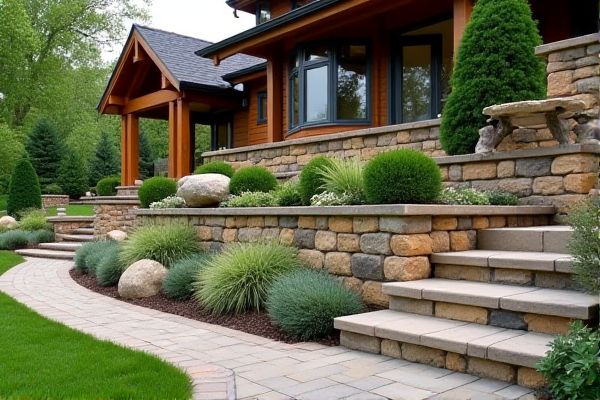
Landscape boulders offer a natural, rugged aesthetic and are ideal for creating organic features or boundaries, while retaining wall blocks provide uniformity and structural support for soil retention with customizable designs. Understanding the pros and cons of each option will help you choose the best solution for your outdoor project--read on to explore detailed comparisons and expert tips.
Table of Comparison
| Feature | Landscape Boulders | Retaining Wall Blocks |
|---|---|---|
| Material | Natural stone | Concrete, stone, or engineered materials |
| Function | Decorative, natural aesthetic | Structural support, soil retention |
| Installation | Requires heavy equipment, placement | Stacked with interlocking design, mortar or dry-fit |
| Durability | Long-lasting, erosion resistant | Strong, engineered for load-bearing |
| Cost | Typically higher due to size and weight | Often more cost-effective and easier to install |
| Design Flexibility | Limited by natural shapes | Highly customizable shapes and sizes |
| Maintenance | Low maintenance | Occasional repairs, cleaning |
| Typical Use | Garden borders, focal points, landscaping accents | Terracing, hillside stabilization, garden retaining walls |
Introduction to Landscape Boulders and Retaining Wall Blocks
Landscape boulders are large, natural stones used for decorative purposes, adding a rugged, organic look to your outdoor space while also helping with erosion control and defining garden areas. Retaining wall blocks are manufactured, uniform pieces designed to create stable, tiered walls that support soil and prevent erosion on sloped terrain. Choosing between landscape boulders and retaining wall blocks depends on your project's aesthetic goals, structural needs, and site conditions.
Key Differences: Boulders vs Retaining Wall Blocks
Landscape boulders are large, natural stones used primarily for aesthetic appeal and organic shaping in outdoor spaces, while retaining wall blocks are manufactured, uniform units designed to interlock and provide structural support for soil retention. Boulders offer irregular shapes and textures that create a more natural look, whereas retaining wall blocks provide consistent size and stability necessary for building durable, level walls. The choice between boulders and retaining wall blocks depends on the project's functional requirements and desired landscape design style.
Visual Appeal and Aesthetic Impact
Landscape boulders offer a natural, rugged aesthetic that blends seamlessly with garden environments, creating organic focal points and enhancing outdoor scenery. Retaining wall blocks provide a uniform, structured appearance, available in various shapes and colors to complement modern or traditional landscape designs. Your choice depends on whether you prefer the rustic charm of boulders or the clean, engineered look of retaining wall blocks to elevate your outdoor space's visual appeal.
Durability and Longevity Comparison
Landscape boulders offer exceptional durability and natural resistance to weathering, ensuring long-lasting stability in any outdoor environment. Retaining wall blocks, while designed specifically for structural support, may require periodic maintenance or replacement due to mortar degradation or shifting over time. You can expect landscape boulders to generally outperform retaining wall blocks in longevity, making them a superior choice for enduring landscape features.
Installation Process: What to Expect
Landscape boulders require minimal groundwork and can be placed directly on prepared soil or gravel, making installation faster but less uniform. Retaining wall blocks demand precise leveling, compacted base, and sometimes mortar or interlocking systems, ensuring structural stability and longevity. Your choice impacts installation complexity, with boulders offering simplicity and natural appeal while retaining wall blocks provide engineered strength and clean lines.
Cost Analysis: Upfront and Long-Term
Landscape boulders typically have higher upfront costs due to their natural weight and irregular shapes, which can increase delivery and installation expenses. Retaining wall blocks offer a more uniform size and are often easier and quicker to install, resulting in lower initial labor costs and potential savings over time. Your long-term costs with retaining wall blocks may also be reduced by their engineered durability and modular design, minimizing maintenance compared to natural boulders prone to shifting or weathering.
Environmental Impact and Sustainability
Landscape boulders have a lower environmental impact due to their natural state, requiring minimal processing and transportation-related emissions compared to manufactured retaining wall blocks. Retaining wall blocks often involve energy-intensive manufacturing processes, including quarrying, molding, and curing, which increase their carbon footprint. Selecting locally sourced landscape boulders can enhance sustainability by reducing transport emissions and preserving natural ecosystems.
Ideal Applications and Best Uses
Landscape boulders excel in creating naturalistic garden features, erosion control, and defining informal seating areas due to their irregular shapes and robust durability. Retaining wall blocks are best suited for constructing stable, tiered retaining structures, terracing slopes, and creating precise boundary delineations thanks to their uniform size and interlocking design. Selecting between the two depends on whether the project requires organic aesthetic appeal or structural support with modular assembly.
Maintenance Requirements and Considerations
Landscape boulders require minimal maintenance, primarily involving occasional cleaning and repositioning after heavy weather or soil movement, whereas retaining wall blocks often need periodic inspection for structural integrity and potential repairs to mortar or block alignment. Retaining wall blocks may also demand regular drainage system upkeep to prevent water buildup and erosion behind the wall, which is less of a concern with spaced or naturally placed boulders. Considering long-term durability, boulders offer a low-maintenance, natural option ideal for rustic aesthetics, while retaining wall blocks provide engineered stability with moderate upkeep for formal landscaping projects.
How to Choose: Factors to Consider
Selecting between landscape boulders and retaining wall blocks depends on factors such as durability, aesthetic preference, and functionality. Landscape boulders provide a natural, rustic look ideal for informal designs and erosion control, while retaining wall blocks offer uniformity and structural stability for terracing or garden bed delineation. Consider your yard's soil type, drainage requirements, and long-term maintenance to ensure your choice enhances both form and function effectively.
 homyna.com
homyna.com